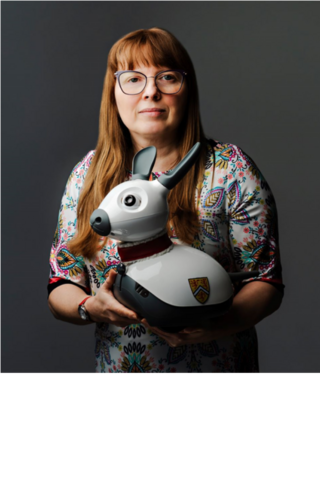
The artificial intelligence (AI) research area involves theory, methods, operations and systems design that concern the perception, recognition and analysis of patterns of objects (visual, textual, numeric or multimedia) and building systems, machines and programs that exhibit adaptable and intelligent behaviour. Several sub-areas in artificial intelligence include sensors management and perception, affective computing, activity recognition, data mining and knowledge discovery, cognitive robotics, cooperative intelligent systems, biometrics, video and image analysis, natural speech recognition, human-machine interaction and applications. These areas and sub-areas are the cornerstones of many applications ranging from intelligent transportation systems to service robotics, from speech transcription to document classification and clustering, from computer vision to emotion recognition, and from prediction of commodities to intelligent power engineering.
Members of the AI area are renowned researchers in their fields, producing large amounts of IP, characterized by more than 50 patents and five spin-off companies. AI researchers organize, every year, several international conferences and workshops in the field. The AI area attracts some of the best researchers and graduate students from all parts of the world. Following graduation, AI graduate students are highly sought-after by academic institutions and industry. Research and training are completed using the most recent software and hardware available in the field; of particular note, these courses are rarely taught in other institutions. Graduate students are known to also generate large amounts of IP, leading to patents and software products.
Faculty members participating in pattern analysis and machine learning research:
Otman Basir

Biography
Dr. Otman Basir is a professor in the Department of Electrical and Computer Engineering at the University of Waterloo. He is also the Associate Director of the Waterloo Institute for Health Informatics Research, Director of Urban Informatics Corporation and Associate Director for the Pattern Recognition and Machine Intelligence Laboratory.
Dr. Basir’s research spans a variety of cutting-edge topics, including Intelligent Embedded Systems, Sensory Systems Design, Biologically Inspired Intelligent Systems, and Human-Computer Interface (HCI) Systems. He has authored and co-authored over 400 scientific publications and holds a remarkable 121 issued and pending patents.
In addition to his academic achievements, Dr. Basir is an entrepreneur. He is the founder, president, and CEO of Intelligent Mechatronic Systems (IMS), a leader in telematics and infotainment technologies. IMS is at the forefront of the connected car industry, merging telematics and infotainment technologies to create safer, smarter, and more sustainable driving experiences. Dr. Basir is also a co-founder of Voice-Enabled Systems and Technology.
Dr. Basir's outstanding contributions have earned him numerous prestigious accolades, including the Ontario Premier Research Excellence Award (PREA), the Canada Foundation Innovation Award, the Academic Leadership Award from the University of Guelph, and the Professor of the Year Award from the University of Guelph. His innovative work continues to influence both academia and industry.
Research interests
- Intelligent embedded systems
- Sensory systems design
- HCI/HMI systems
- Biologically inspired intelligent systems
- Hybrid systems
- Computer Engineering
- Software Engineering
- Embedded Neuro-Fuzzy systems design
- Reconfigurable sensor networks
- Mission critical systems
- Adhoc sensor networks
- Sensor fusion and integration
- Non-destructive testing (NDT)
- Machine vision
- Gesture recognition
- Discourse analysis
- Natural speech understanding
- Operational Artificial Intelligence
- Cybersecurity
- Infrastructure integrity
Elliot Creager

Biography
Dr. Elliot Creager is an assistant professor in the Department of Electrical and Computer Engineering at the University of Waterloo. He is also a faculty affiliate at the Vector Institute for Artificial Intelligence and the Schwartz Reisman Institute for Technology and Society.
Dr. Creager’s research spans a range of topics within machine learning, with a focus on algorithmic fairness, representation learning, and robustness. He earned his PhD from the University of Toronto, where he also interned and conducted research at Google Brain in Toronto during his graduate studies.
Research interests
- Artificial Intelligence
- Machine Learning
- Out-of-distribution Robustness
- Algorithmic Fairness
- Representation Learning
- Sequential Decision Making
- Causal Inference
Mark Crowley

Biography
Dr. Mark Crowley is an associate professor in the Pattern Recognition and Machine Intelligence group in the Department of Electrical and Computer Engineering at the University of Waterloo. He received his Ph.D. and M.Sc. in Computer Science from the University of British Columbia working in the Laboratory for Computational Intelligence, and a B.A. in Computer Science from York University in Toronto. He did a postdoc at Oregon State University working with Tom Dietterich’s machine learning group.
Dr. Crowley's research focuses on algorithms, tools and theory at the intersection of machine learning, optimization, and probabilistic modelling. In particular, he is interested in the challenges of traditional machine learning and optimization algorithms that arise in domains with spatial dynamics and very large amounts of data. He often works in collaboration with researchers in other fields such as sustainable forest management, ecology, and resource economics. He is an active part of building the interdisciplinary Computational Sustainability research community and blogs on this topic as well as democratic reform and the impact of AI technology on society.
Research interests
- Artificial Intelligence
- Machine Learning
- Reinforcement Learning
- Decision-making under uncertainty
- Probabilistic Graphical Models
- Causal Modeling
- Big Data Analytics
- Optimization
- Game Theory
- Autonomous Driving
- Medical Imaging
- AI for Science
- Material Design
- AI for Video Games
Kerstin Dautenhahn

Biography
Dr. Kerstin Dautenhahn is a professor in the Department of Electrical and Computer Engineering at the University of Waterloo. She is a Tier 2 Canada Research Chair in Socially Intelligent Robotics. Previously she held a Canada 150 Research Chair in Intelligent Robotics. Dr. Dautenhahn is cross-appointed to the David R. Cheriton School of Computer Science, the Department of Mechanical and Mechatronics Engineering, and the Department of Systems Design Engineering at the University of Waterloo. She is a visiting professor at the University of Hertfordshire, UK. At Waterloo, she is the Director of the Social and Intelligent Robotics Research Laboratory (SIRRL).
The main areas of her research are human-robot interaction, social robotics, assistive technology, and health technologies. She is editor-in-chief (jointly with Prof. Angelo Cangelosi of the University of Manchester, UK) of the Journal Interaction Studies — Social Behaviour and Communication in Biological and Artificial Systems, published by John Benjamins Publishing Company, editorial board member of Adaptive Behavior, Sage Publications, associate editor of the International Journal of Social Robotics, published by Springer, and associate editor of IEEE Transactions on Cognitive and Developmental Systems. She is an editor of the book series Advances in Interaction Studies, published by John Benjamins Publishing Company. Dr. Dautenhahn is on the Advisory Board of the journal AI and Society (Springer). She is a Fellow of the Royal Society of Canada (RSC), a Fellow of the IEEE, a member of the ACM, and a Lifelong Fellow of AISB, as well as a member of the Executive Board of the International Foundation for Responsible Robotics. Since 2006, she has been part of the Standing Steering Committee of the IEEE conference RO-MAN (Human and Robot Interactive Communication).
Research interests
- Human-Robot Interaction
- Social Robotics
- Robot-Assisted Therapy
- Robot-Mediated Instruction
- Assistive Robotics
- Artificial Intelligence
- Artificial Life
Roya Firoozi

Biography
Dr. Roya Firoozi is an assistant professor in the Department of Electrical and Computer Engineering at the University of Waterloo. Prior to this role, she was a postdoctoral researcher at Stanford University’s Multi-Robot Systems Laboratory. Dr. Firoozi holds a bachelor's degree in mechanical engineering and a Ph.D. in control theory, with minors in optimization and machine learning, from the University of California, Berkeley. Her research lies at the intersection of robotics, artificial intelligence, and control theory, with a focus on enabling safe robot autonomy in interactive, open-world environments.
Research interests
- Robotics aided by generative AI
- Multi-modal perception and planning
- Interactive autonomy in multi-agent systems
- Game theory and distributed optimization for multi-agent interactions
- Safe robot autonomy
Amir-Hossein Karimi

Biography
Dr. Amir-Hossein Karimi is an Assistant Professor in the Department of Electrical and Computer Engineering at the University of Waterloo, and a Faculty Affiliate at the Vector Institute. Before joining Waterloo, he gained extensive industry experience at Meta, Google Brain, and DeepMind, and provided AI consulting services to various startups and incubators.
As leader of the Collaborative Human-AI Reasoning Machines (CHARM) Lab, Dr. Karimi’s research aims to advance the field of artificial intelligence while fostering trustworthy human-AI collaboration. His work explores AI systems that can recover from or amend poor decisions, evaluates AI safety, factuality, and ethics to build trust, and investigates effective ways to combine human and machine strengths. His research spans the intersection of causal inference, explainable AI, and program synthesis.
His work has been featured at leading AI and ML conferences such as NeurIPS, ICML, AAAI, AISTATS, ACM-FAccT, and ACM-AIES. Dr. Karimi has received recognition for his contributions to algorithmic recourse through spotlight and oral presentations, a book chapter, and a well-regarded survey paper published in ACM Computing Surveys.
Research interests
- Artificial intelligence
- Machine learning
- Explainable AI
- Causal inference
- Algorithmic Recourse
- Counterfactual Explanations
- Program Synthesis
- Human-Machine Teaming
- Human-Machine Collaboration
Chrystopher Nehaniv

Biography
Dr. Chrystopher Nehaniv is a full professor in the Departments of Systems Design Engineering and Electrical and Computer Engineering at the University of Waterloo, a position he has held since August 2018. A mathematician, computer scientist, and complex adaptive systems researcher, Dr. Nehaniv is also affiliated with the University of Hertfordshire in the United Kingdom, where he previously served as Director of the Centre for Computer Science & Informatics Research. There, he led research in the Algorithms, Adaptive Systems, and Wolfson Royal Society Biocomputation Research Groups as a professor of mathematical and evolutionary computer sciences.
Before moving to Canada, Dr. Nehaniv was a full professor at the University of Aizu in Japan and held visiting professorships in mathematics at Ibaraki National University, Japan, and the Institute for Mathematics & Informatics at the University of Debrecen, Hungary. He was also a postdoctoral research fellow and lecturer in mathematics at the University of California, Berkeley.
Dr. Nehaniv is the founder of the Waterloo Algebraic Intelligence & Computation Laboratory (WAICL) and, alongside Dr. Kerstin Dautenhahn, co-founded the University of Waterloo's Social and Intelligent Robotics Research Laboratory (SIRRL). He is a member of the Waterloo AI Institute and serves on the steering committee of the Waterloo Institute for Complexity and Innovation (WICI).
An active contributor to the academic community, Dr. Nehaniv is an associate editor for BioSystems, IEEE Transactions on Cognitive and Developmental Systems, Interaction Studies, and Complexity. He previously served as topic editor-in-chief for The International Journal of Advanced Robotic Systems in the areas of AI robotics and human-machine/robot interaction. He has been involved with the IEEE Task Force for Artificial Life and Complex Adaptive Systems since its inception in 2003, serving as Chair from 2012 to 2018 and as Vice Chair since 2018. He is also a member of the IEEE Cognitive and Developmental Systems Technical Committee (2019-present) of the IEEE Computational Intelligence Society.
Research interests
- Algebraic Methods in Algorithms & Applications
- Artificial Intelligence
- Artificial Life & Complex Adaptive Systems
- Algebra & Discrete-Event Dynamical Systems:
- Automata, Permutation Groups, Transformation Semigroups, Interaction Machines, Models of Time
- Systems Biology & Neuroscience: Mathematical & Computational Methods
- Gene-Regulatory Networks & Differentiated Multicellularity
- Interactive Systems Design
- Cognitive Architectures for AI Robotics
- Enactive Experiential & Temporally Extended Intelligence
- Evolvability
- Cognitive\/Social\/ Skill & Linguistic Development in Animals & Artifacts
- Dynamic Networks
- Whole-Part Relations\/Natural Subsystems
- Global Hierarchical Coordinate Systems for Understanding\/Prediction\/Manipulation in STEM
Zhou Wang

Dr. Zhou Wang is a Professor in the Department of Electrical and Computer Engineering at the University of Waterloo. He is a Fellow of the Institute of Electrical and Electronics Engineers (IEEE), the Royal Society of Canada (RSC) – Academy of Science, and the Canadian Academy of Engineering (CAE). In addition, he is a certified Professional Engineer.
Dr. Wang has received numerous prestigious awards, including the 2021 Faculty of Engineering Excellence in Graduate Supervision Award, 2021 Technology Emmy Award, 2017 IEEE Signal Processing Society Sustained Impact Paper Award, and 2015 Primetime Engineering Emmy Award. Other accolades include the 2014 NSERC E.W.R. Steacie Memorial Fellowship Award, 2013 IEEE Signal Processing Magazine Best Paper Award, 2009 IEEE Signal Processing Society Best Paper Award, and several NSERC and Ontario Early Researcher grants.
An active contributor to the academic community, Dr. Wang has served on the editorial boards of IEEE Transactions on Image Processing, IEEE Transactions on Circuits and Systems for Video Technology, IEEE Journal of Selected Topics in Signal Processing, and IEEE Signal Processing Letters, among others. He has also contributed to the IEEE Technical Committees on Image, Video and Multidimensional Signal Processing and Multimedia Signal Processing.
Dr. Wang’s research interests encompass signal and image processing, computational vision and pattern analysis, multimedia coding and communications, and biomedical signal and image processing. With over 200 publications and more than 80,000 citations, his work has made a significant impact on the field.
Research interests
- Image processing
- Digital signal processing
- Computational vision
- Pattern recognition
- Machine Learning
- Multimedia communications
- Image and video compression
- Visual perception
- Biomedical signal processing
- Medical imaging
Paul Ward

Biography
Paul Ward is an Associate Professor in the Department of Electrical and Computer Engineering at the University of Waterloo. He is also a faculty fellow at the IBM Centre for Advanced Studies.
Professor Ward’s expertise lies in the area of distributed systems and computer networks. In distributed computing, his work focuses on distributed-application management, and more generally on dependable and self-managing distributed systems, with a recent focus on fault detection and diagnosis in Web Services. Professor Ward’s work in networks focuses on raising the abstraction level of the network from one of packet delivery to a service-oriented network, specifically concentrating on problems of service discovery, and the problem of semantic coupling, both of functional and non-functional attributes. He has also studied problems of capacity and fairness in wireless mesh networks and routing in delay-tolerant networks.
Professor Ward co-holds two patents; ‘Brokering Web Mobile Services’ which provides a novel mobile web services discovery method that is capable of fulfilling the requirements from both the clients and providers. His second patent is a ‘Method for Solving Application Failures using Social Collaboration’ in which a computer-implemented method, system and computer usable program code for solving an application failure using social collaboration are provided.
Research interests
- Distributed Systems Management
- Dependable Distributed Systems
- Autonomic Computing
- Peer-to-Peer Computing
- Wireless Mesh Networks
- Mobile Ad Hoc Networks
- Communication Systems
- Information Systems
- Computer Engineering
- Software Engineering
- Connectivity and Internet of Things (IoT)
- IoT Devices
- Application Domains
- Communications and Access
- Networking and Data
- Dependability and Security
Adjunct Faculty members participating in pattern analysis and machine learning research:
George Freeman (Adjunct)

Biography
Dr. George Freeman is an Adjunct Professor Emeritus in the Department of Electrical and Computer Engineering at the University of Waterloo.
His research focuses on signal processing for digital communications, the development of optimal lossless data compression algorithms, and applications in storage and recognition for speech and image coding.
Beyond his research achievements, Dr. Freeman has been honored with the Dedicated Service Award from the Canadian Association of University Teachers, recognizing his outstanding service to academic staff associations.
Research interests
- Signal Processing
- Wavelet Analysis
- Medical Image Processing
- Speech Recognition
- Data Compression
Fakhri Karray (Adjunct)

Biography
Dr. Fakhri Karray is a Professor Emeritus in the Department of Electrical and Computer Engineering. He previously held the Loblaws Research Chair in Artificial Intelligence and served as co-Director of the University of Waterloo Artificial Intelligence Institute.
His research focuses on operational artificial intelligence, cognitive machines, natural human-machine interaction, and autonomous intelligent systems. Dr. Karray’s work has applications in the development of cognitive, self-aware machines, robots, and vehicles, as well as in predictive analytics for supply chain management and intelligent transportation systems. He is a Fellow of the Canadian Academy of Engineering, the Engineering Institute of Canada, and the IEEE, and has served as an IEEE Distinguished Lecturer.
Research interests
- Operational Artificial Intelligence
- Computational intelligence
- Natural Human-machine interaction
- Cognitive Robotics
- Autonomous and self aware machines
- AI Based Supply Chain